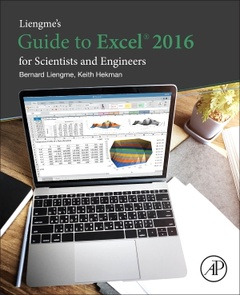Liengme's Guide to Excel 2016 for Scientists and Engineers (Windows and Mac)
Auteurs : Liengme Bernard, Hekman Keith

Liengme?s Guide to Excel 2016 for Scientists and Engineers is a completely updated guide for students, scientists, and engineers who want to use Microsoft Excel 2016 to its full potential, whether you?re using a PC or a Mac. Electronic spreadsheet analysis has become part of the everyday work of researchers in all areas of engineering and science. Microsoft Excel, as the industry standard spreadsheet, has a range of scientific functions that can be utilized for the modeling, analysis, and presentation of quantitative data. This text provides a straightforward guide to using these functions of Microsoft Excel, guiding the reader from basic principles through to more complicated areas such as formulae, charts, curve-fitting, equation solving, integration, macros, statistical functions, and presenting quantitative data.
Dr. Keith Hekman received his BSE degree from Calvin College and received his Master's and Ph.D. in Mechanical Engineering from the Georgia Institute of Technology. Currently he is a Professor of Mechanical Engineering at Gordon and Jill Bourns College of Engineering at California Baptist University where he has taught a freshman Excel and AutoCAD course for the past 11 years. Prior to coming to CBU, he taught at Calvin College and the American University of Cairo.
- Content written specifically for the requirements of science and engineering students and professionals working with Microsoft Excel, brought fully up to date with Microsoft Office release of Excel 2016.
- Features of Excel 2016 are illustrated through a wide variety of examples based on technical contexts, demonstrating the use of the program for analysis and presentation of experimental results.
- Where appropriate, demonstrates the differences between the PC and Mac versions of Excel.
- Includes many new end-of-chapter problems at varying levels of difficulty.
Date de parution : 08-2019
Ouvrage de 414 p.
19x23.3 cm
Thèmes de Liengme's Guide to Excel 2016 for Scientists and Engineers :
Mots-clés :
QAT; ribbon control; status bar; mathematical operators; formatting; subscripts; superscripts; print preview; page layout; page breaks; AUTOSUM; insert function; trigonometry functions; exponential functions; array formulas; matrix functions; financial functions; Boolean functions; IF function; IFERROR function; quadratic equation solver; SUMPRODUCT; filtering; XY Chart; LINEST function; multilinear regression; LOGEST; array function; macro; Gaussian curve fit; optimization problems; trapezoid rule; Simpson's ? rule; Monte Carlo techniques; Euler’s Method; Runge-Kutta Methods; frequency distribution; confidence limits; pooled standard deviation; calibration curve


